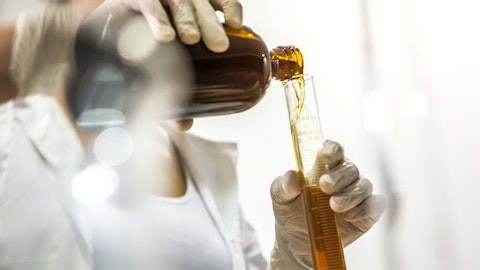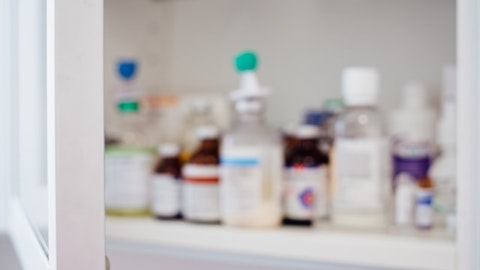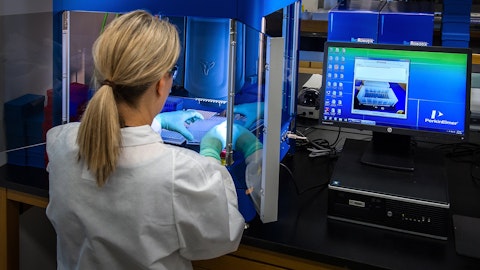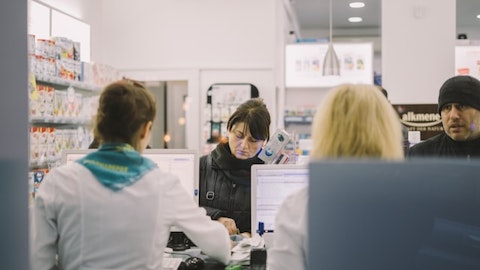Phil Nadeau: That’s very helpful. Thanks for taking our questions.
David Meeker: Thanks, Phil.
Operator: One moment for the next question. The next question comes from Whitney Ijem with Canaccord. Your line is open.
Whitney Ijem: Hey, guys, thanks for taking the questions. I have a few, but one quick follow-up on the — last comment on the work to get those 30 patients back on. Is the genetics diagnosis not enough here? Or you’re saying those patients didn’t have genetics and there was more of a clinical diagnosis need?
Jennifer Lee: So there’s two components for this particular payer in terms of securing access, which is both the genetics component as well as the clinical diagnosis component. So both of those are, you know, in process and ongoing.
Whitney Ijem: Got it. Got it. Okay. That’s helpful. And then in Japan, have you — is there any reason to expect, I guess, differential PK or safety and efficacy in the Japanese group there? Do you have data in any of your other trials in Japanese patients to speak to that?
David Meeker: No, I mean, we have a very, very small number of Asian patients, which doesn’t tell you exactly Japan. Of course, there’s nothing that stands out in the small number of patients that we have, one. What is different is, you know, it’s a smaller — physically smaller population. And so, we designed this trial for, you know, Western society, and the cutoff for obesity of greater than 30 is well above, you know, what would be a cutoff, you know, greater than 25 in Japan, as determining an individual who’s overweight. So for Japan’s patients to get into the trial, they need to meet our inclusion criteria that we set for the Western society. So that significantly narrows a bit the population we’ll be targeting for the trial.
But in terms of your question about PK and differences, I mean, we have a ton of PK data, you know, in pediatrics, we have PK data down, you now, we have very, very young kids. And there’s a consistency in the way this drug performs. So there’s no reason to believe that we’re going to have a significant difference in how this drug is handled by the Japanese population.
Whitney Ijem: Got it. Okay. And then last question, should we be expecting an update in HO from the Phase 2 LTE this year with additional follow-up beyond the October update from last year?
David Meeker: I don’t think so. I mean, we’re in the process of putting out publications. We haven’t, you know, planned necessarily another follow-up on the meeting. We’ll re-evaluate that if we do anything, it’ll be in the fall. But, yeah, it’s not the current plan. I think we’ve given a good series of updates there for the moment.
Whitney Ijem: Okay. Great. Thank you very much.
David Meeker: Thank you.
Operator: One moment for the next question. The next question comes from Dae Gon Ha with Stifel. Your line is open.
Dae Gon Ha: Hey, good morning, guys. Thanks for taking my questions and congrats on the progress. Maybe a few. I’ll just kind of starting with the EU side of the BBS equation. I was wondering if Yann could comment on sort of the German launch progress. I think you mentioned 15 academic centers or large treatment centers. I didn’t — maybe I missed it, but did you mention how many patients are currently on therapy? And as we think about the Spain and Italy launch, how could the dynamics there differ versus the German launch? And then switching over to the clinical side, if we think about the HO, I would kind of expect that the Phase 3 HO enrollment progress to kind of facilitate, if not, add tailwind to your other signal, if not 718 trial. So can we expect one have 25 data from all three of those studies? And if so, how should we think about the cadence between the three? Thanks so much.
David Meeker: Yeah. Yann, do you want to go first? German launch?
Yann Mazabraud: Yes, I will start with Germany. So, no, I have not given patient number, but I can comment on the launch for sure. So, as I said, it’s progressing well. We are meeting our expectations. The country is led by a very experienced GM. And our field team does interact with all the key German centers. So again, in terms of field activity interactions, I think we are doing a very good job. What is important is that the feedback from the HEPs and the feedback from the patients through the HEPs is very good, and the discontinuation rate that we observe is low. We also have kicked off two large patient identification programs, one for the adult population, one for the pediatric population, which will help us to identify new patients for ’25 and beyond.
So I don’t have specific numbers for Germany, but I can tell you that it’s going well. Spain and Italy, I can maybe speak about the two countries together because there are many common dynamics, so it will be slow and steady as usual, or as often with rare diseases. Both countries are single-payer systems and have a national negotiated price, which is very good. They are also very decentralized. So we have to engage with both regional payers and local hospitals in individual states. And that’s why it will be slow and steady. Of course, we focus initially on where the identified patients are and in the fastest regions from a market access point of view. As I said earlier, there are 21 states in Italy and 16 in Spain. So we are focusing on the one with the more patients and the fastest pace in terms of access.
And in general, what I would say about Europe, and Hunter mentioned that also in his slides for 2024, Germany will be the main driver, and both Spain and Italy will become more meaningful in 2025 when we will also have UK and the Netherlands kicking in.
David Meeker: And Dae Gon, the — your clinical question, which is, yeah, we enrolled incredibly well, the Phase 3 trial, and that does speak to demand interest in this trial. And that for sure will spill over into potential enrollments for both of our weekly program and the small molecule daily oral program. Until we get, neither one of those programs have we dosed an HO patient? As I said, first, for the weekly, we’ve got to go through the healthy volunteer study for the small molecule. We’re just getting those sites up and haven’t quite gotten to the point where we’re dosing. So until we get that part of the trials established, I don’t have line of sight to when exactly we would guide to readouts here. So I’m going to defer that what we will commit to. It will for sure be 2025. As you can imagine, we’re highly motivated to get it as soon as possible, but I have to leave it there for this moment.
Dae Gon Ha: Cool. Thanks so much.
David Meeker: Thanks. Operator Please stand by for the next question. The next question comes from Joseph Stringer with Needham. Your line is open.
Joseph Stringer: Hi, good morning. Thanks for taking our questions. First one on just looking at the [ENRx] (ph) so it seemed to be down slightly the last two quarters. Just wondering if you could comment on this trend. Do you feel like you’d reach a point in the US where there’d be a relatively steady stage quarterly new prescription add? And what would that look like? And then secondly, on HO in Japan, can you maybe talk about the HO patient community and organization relative to what it is in the US? Are there any significant differences in diagnosis or registries? And also are there any differences in the outlook or attitude of how the physicians in Japan view using, say, the GLP weight loss drug to try and treat HO compared to what physicians in the US view it as? Thank you.
Hunter Smith: Okay. Joe, I’ll start and then hand it over to Jennifer. I think we’ve tried to be pretty consistent in our messaging around scripts that we view that as the hardest thing to predict. So we expect variability. We feel very good about the level that we’re at, both from Rx growth and reimbursed patients on therapy perspective. But we do think it’s going to be consistently difficult to model if you will. And so, and Jennifer can obviously go into the details as to the why. But —
Jennifer Lee: Yeah. You know, what’s interesting is sometimes when you look at some of the scripts that came, it was — you know, like it could be up to a year from the first interaction for the physician to be educated and then to be, you know, really evaluating their patients, to even come to a BBS patient diagnosis and then eventually go to a script, which is what makes it difficult just in terms of really being able to predict quarter-over-quarter. What I will say is, like, we took a — take a look at different metrics, including, as we outlined, sort of like the new number of prescribers, who have been increased and educated in terms of awareness of BBS. And that has remained consistent quarter-over-quarter, as well as the ones that have already prescribed and had a good experience with their patients.
Hence, they are also interested in terms of putting any additional patients that come across. And that’s what we want in terms of them really experiencing the benefits of this specific therapy for the BBS patient population. So we remain positive in terms of the opportunities for growth. You know, there’s still ways to go in terms of really achieving the prevalence estimates that we have out there, and we’re just going to continue to grow quarter-over-quarter.
David Meeker: And Yann, do you want to provide a little more color on the patient situation in Japan?
Yann Mazabraud: Yes. So I can speak about HO in Japan. And one of your questions was also difference or comparison with the US. So one thing that we have observed first is that when these patients in the US and in Europe are most of the time under the care of endocrinologists after the surgery. In Japan, they are really followed closely by those two medical specialties, which I think is good because, from a patient identification point of view, we have two medical specialties that we can speak to. But so we have observed that very early, and we will make sure that we are covering those two specialties very well. One of your questions was about registries, yes, there are two registries existing led or under the umbrella of scientific societies.
And we have worked with those societies and with these registries to set up the prevalence numbers that I’ve given earlier. So, yes, they exist. They are well-filled, and we are already working or using them. Another good aspect from a patient point of view in Japan, as you know, there are very good data, our hospital data. So we have used claims database analysis for the prevalence, but we will continue to use that also to identify where the largest centers are, where the patients are, and, of course, a lot of data that will help us from an economic — health economic point of view. One of your questions was about the use of other antioxidant medication. I mean, it’s a bit early for us to say, but what we have observed two weeks ago during the symposium, there were a lot of questions from the audience to the speakers and to — about that.
What should they do? And — so I can only report what we have heard. So the President of the Japanese Society stood up and mentioned that given the very specifics of HO and the mechanism of action of setmelanotide and the precision medicine aspects, they should consider setmelanotide to treat these patients. So very early to say, but I think we observe and well observed, and we are interacting with the market. That sounds very promising for us.
David Meeker: Great. Thank you.
Tazeen Ahmad: Great. Thank you so much for the — yeah, thank you so much for the color.
David Meeker: Next question.
Operator: One moment for our last question. The last question comes from Michael Higgins with Ladenburg Thalmann. Your line is now open.
Michael Higgins: Thank you, operator. And our congrats as well, guys, in the quarter. Given the time to have — a quick one here. David, if you could confirm for us — marketing in Japan and reaching that patient population? Thanks.
David Meeker: Mike — Michael, I missed it. So I confirm it was Japan question. I was just going to — yeah.
Michael Higgins: Hopefully, the call will go through here. Just trying to clarify your marketing plan in Japan. Are you going to go alone? Are you going to partner with others?
David Meeker: Yeah. Okay. Got it. Perfect. Yep. Thanks. Yann?
Yann Mazabraud: Yes. So as I said earlier, so we will go alone. We will establish an affiliate in Japan. We have already two people working for us in the ground. One, one person in my team is also dedicated to the market, and we will build the structure in the next months as needed. As you know, in Japan, there are some positions that are mandatory before filing. So we are currently looking for those. And as I also said, we are working with these two consultants to establish relationships with the European leaders and the Medical Society. So, yes, standalone and moving forward like that.
David Meeker: Yeah. And just remind, if I think, you know, our overall strategy and strategy here is being successful in rare diseases, particularly outside the US. It’s all about the people you have on the ground, and, you know, we’ve done well with people like Yann, who have deep experience. And for Japan, we’re going to dip back into that Genzyme — Sanofi Genzyme roster as well. I’m looking for some people we’ve worked with in the past, again, who have high familiarity with the Japanese market and like. So when Yann said, we feel we can do this alone, we’ve talked to partners and, you know, we’ll never say never on partnering, but I think this is approachable and given the size and value of this to overall Rhythm picture. And the bar to do anything else but go direct would be extremely high. So with that, I think that was the last question.
Michael Higgins: Thanks guys.
David Meeker: Yeah. Thanks, Mike. So thanks all again. Sorry. Yeah. So I think, thanks again, everybody, for tuning in. And we very much look forward to reporting out again in another busy year coming up for Rhythm. We talk soon.
Operator: This concludes today’s conference call. Thank you for participating. You may now disconnect.



